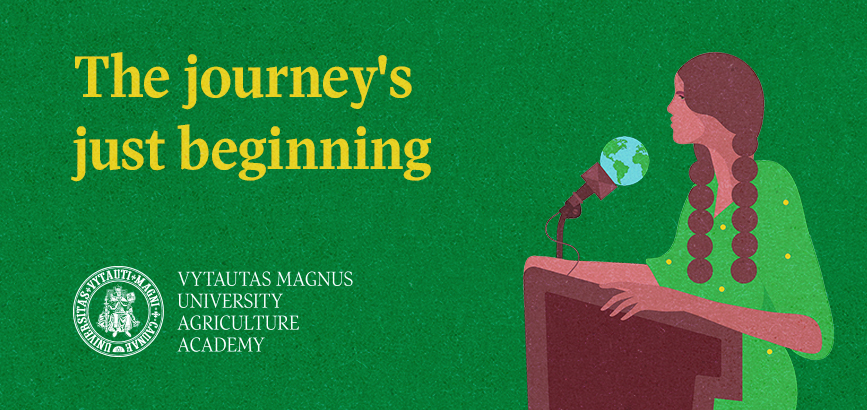About the Faculty
Mission
The mission of the Faculty is to create and disseminate knowledge in engineering and related disciplines for sustainable agriculture, food, water and rural development, for social and economic progress, and for the creation of a complete and safe living environment.
Vision
The vision of the Faculty is to be a strong and recognized university school of engineering sciences in the Baltic region and beyond, to cooperate with the strongest representatives of engineering in Lithuania and abroad, to be open to innovations, to create them and to constantly improve.
History
At 25th of June, 1946 Faculty of Engineering Sciences has been established at the Lithuanian Academy of Agriculture. In the autumn of that year, 50 students were admitted to each specialty: hydromelioration, land management and agricultural mechanization.
Together with the Faculty four departments were established: Geodesy, Physics, Land Reclamation, and Agricultural Mechanization. The Department of Engineering Structures and Department of Tractors and Automobiles were established in 1947.
Since the 1st of May of 1948 the faculties of Hydromelioration, Land Management and Agricultural Mechanization were formed as separate faculties.
The departments of Hydraulic Structures and Mathematics-mechanics were established in 1949 at the Faculty of Hydromelioration, and the department of Land Use Planning – at the Faculty of Land Management. In 1950 the faculties of Hydromelioration and Land Management were merged into a single faculty. In 1961 the departments of Land Use Planning and Geodesy were merged. In 1967 the Department of Drawing Geometry and Graphics was established in the faculty, and the Department of Mathematics was transferred to the Faculty of Agricultural Mechanization. In 1977, the Department of Operation of Hydromelioration Systems (later named Water Management) was established. During the Revival, the activities of hydraulic engineering specialists expanded significantly to include more areas of water engineering, which changed the name of the faculty to Water and Land Management in 1990. In 1996, the faculty had 6 departments: Physics, Hydraulic Engineering, Land Reclamation, Building Structures, Water Management and Land Management. During the reorganization of the country’s scientific institutions, in 2010. The Lithuanian Institute of Water Management (former Lithuanian Hydraulic Engineering and Land Reclamation Research) in Vilainiai was integrated into the faculty structure. In 2012, after the reorganization of structural divisions of Aleksandras Stulginskis University, three institutes were established at the faculty – Hydraulic Engineering, Water Resources Engineering and Land Management and Geomatics. In 2014, the Faculty established an Aquaculture Center.
Department of Machine Repair and Department of Thermal Engineering and Agricultural Electrification were established in 1949 at the Faculty of Agricultural Mechanization. Department of Machine Repair and Department of Thermal Engineering and Agricultural Electrification – in 1949. The Department of Machine Exploitation was established in 1961. In the period 1966–1976 was established the Department of Labour Protection and Practical Training, the Department of Animal Husbandry Mechanization and Thermal Engineering, the Department of Machinery Parts, the Department of Electrical Machinery and finally the Department of Mathematics assigned to the Faculty. Separate Faculty of Electrification of Agriculture was established in 1976 with a increase in the number of students. In 1985 the Faculty of Agricultural Mechanization established the Department of Pedagogy and Teaching Methodology. In 1994, with a decrease in the number of students, the Faculty of Electrification of Agriculture was reconnected to the Faculty of Agricultural Mechanization that changed its name to the Faculty of Agricultural Engineering in the same time. In 1996 the Faculty of Agricultural Engineering had 6 departments: Agroenergy, Mechanics, Occupational Safety and Engineering Management, Heat and Biotechnology Engineering, Transport and Power Machinery, Agricultural Machinery. In 2010 the Institute of Agroengineering became a separate unit of the faculty. In 2012, the former 6 departments and the Institute of Agro-Engineering merged into 3 institutes: Energy and Biotechnology Engineering, Power and Transport Machinery Engineering, Agricultural Engineering and Safety.
Over the course of the existence of the faculties, more than 20,000 students have graduated from both faculties.
Currently, the Faculty of Engineering hold 55 positions of lecturers and researchers, including 11 professors. There are three doctoral schools in the field of Technology: Environmental Engineering, Mechanical Engineering, and Transport Engineering, with 30 doctoral students. Graduates of secondary education programs are invited to study in the Bachelor’s study programs in Sustainable Engineering, Agricultural Mechanical Engineering, Land Use Planning and Real Estate Evaluation. For successful bachelor graduates, it is offered to choose one of 5 master’s degree programs: Hydraulic Engineering, Sustainable Energy, Agricultural Engineering and Management, Mechanical Engineering (three specializations: machine reliability engineering, transport engineering, agricultural machinery engineering), Land Use Planning.
Over the course of the existence of the Faculty, scientific activities have developed depending on the priorities of the time and technologies. Currently, the following scientific activities are formed in the Faculty:
- Green construction;
- Biomass engineering and renewable energy resources;
- Innovative aquaculture technologies;
- Smart land and water engineering;
- Smart agricultural and mobile machinery systems;
- Sustainable engineering systems, climate change mitigation;
- Tribological processes in mechanical and biological systems.
STRATEGIC PLAN OF THE FACULTY OF ENGINEERING FOR THE YEARS 2025-2027












